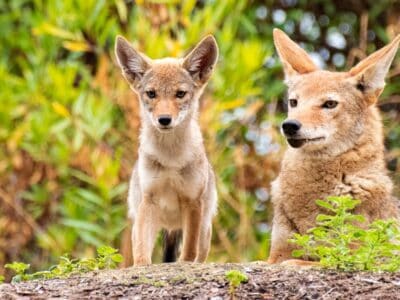Groundhog (Woodchuck)
Marmota monax
They whistle to each other to warn of approaching danger!
Advertisement
Groundhog (Woodchuck) Scientific Classification
- Kingdom
- Animalia
- Phylum
- Chordata
- Class
- Mammalia
- Order
- Rodentia
- Family
- Sciuridae
- Genus
- Marmota
- Scientific Name
- Marmota monax
Read our Complete Guide to Classification of Animals.
Groundhog (Woodchuck) Conservation Status
Groundhog (Woodchuck) Facts
- Name Of Young
- pups
- Group Behavior
- Social
- Fun Fact
- They whistle to each other to warn of approaching danger!
- Estimated Population Size
- Over 200 million
- Biggest Threat
- Carnivores, humans
- Most Distinctive Feature
- their four long, sharp incisors
- Other Name(s)
- Woodchuck, whistlepig
- Gestation Period
- 32 days
- Litter Size
- 2 to 6
- Habitat
- Forest, woodlands, suburban gardens
- Predators
- Coyotes, badgers, bobcats, foxes
- Diet
- Omnivore
- Type
- rodent
- Common Name
- Groundhog, Woodchuck
- Number Of Species
- 12
- Location
- United States and Canada
Groundhog (Woodchuck) Physical Characteristics
- Color
- Brown
- Grey
- Skin Type
- Fur
- Top Speed
- 10 mph
- Lifespan
- 6 years in the wild, 14 in captivity
- Weight
- 10 to 13 pounds
- Height
- 1 ½ to 2 feet
- Length
- 2 feet
- Age of Sexual Maturity
- 2 years
- Age of Weaning
- 6 weeks
View all of the Groundhog (Woodchuck) images!
“Unlike other marmots, they prefer low-lying areas.”
The groundhog is a large lowland rodent found throughout most of the United States. and Canada. Like all rodents, they are curious, intelligent animals who can survive in various environments. They belong to a group of ground squirrels known as marmots. Other names for this animal include woodchuck, thick wood badger, moonack, land beaver, and whistle pig.
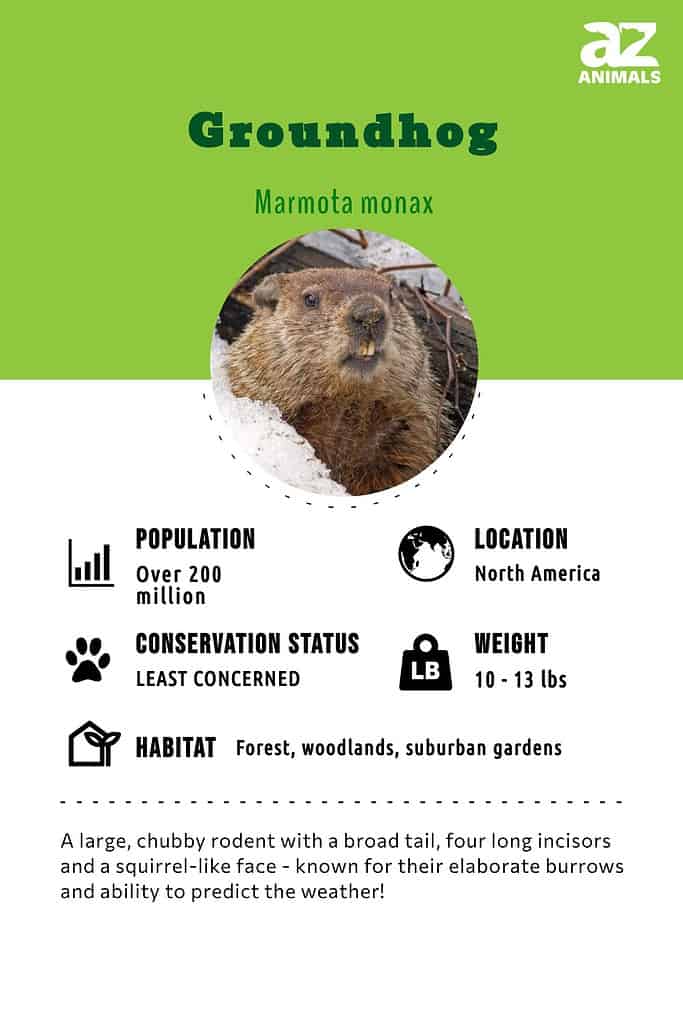
4 Incredible Facts About Groundhogs!
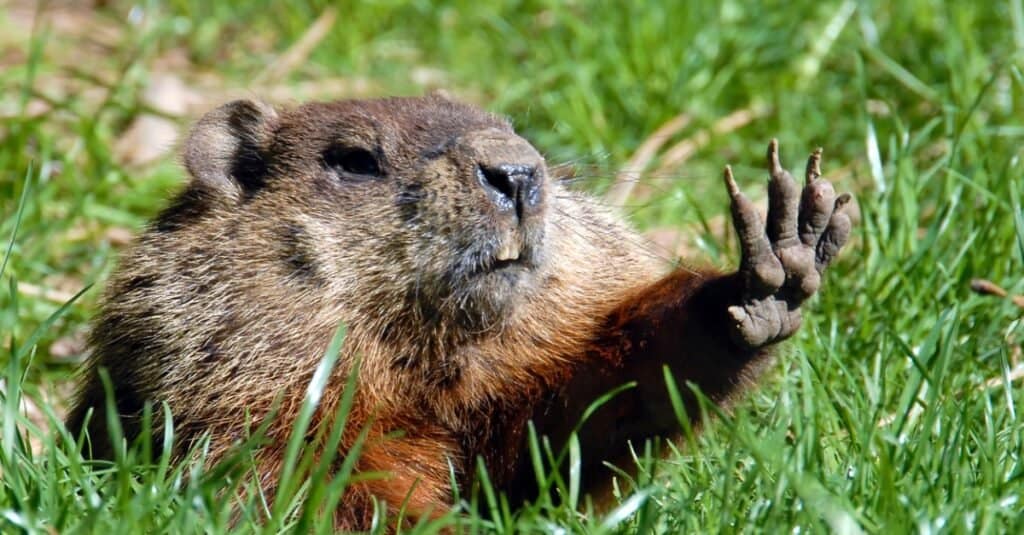
Woodchucks are master burrowers with strong paws and claws made for digging.
©iStock.com/mirecca
- They can climb trees.
- They build large, extensive underground burrows.
- They whistle to each other as warnings.
- They are excellent swimmers.
You can check out more incredible facts about groundhogs.
Scientific Name
Its scientific name is Marmota monax but it is also known as a woodchuck. The name, woodchuck has nothing to do with wood or chucking but stems from the Algonquian word for the animal, wuchak.
Evolution
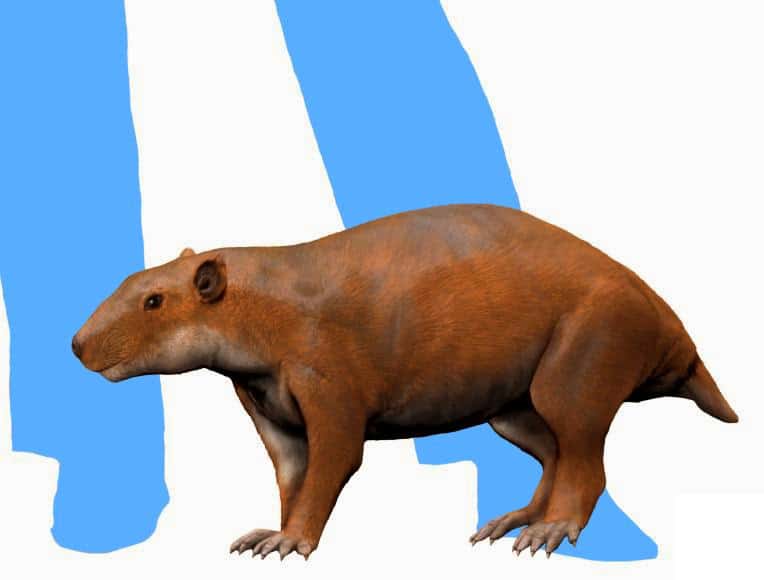
is an ancient ancestor of the groundhog that lived 66 – 70 million years ago.
©https://commons.wikimedia.org/wiki/File:Vintana_NT_small.jpg – Original / License
Not much is known about the earliest relatives of the groundhog, but a fossil discovered in 2014 has solved a piece of the puzzle. Scientists reconstructed fossil fragments found in Madagascar to reveal a five-inch-long skull of an ancient groundhog that lived between 66 and 70 million years ago.
Vintana sertichi was a large rodent-like creature weighing an estimated 20 pounds. This little mammal was small among its giant dinosaur neighbors – but it possessed a powerful bite. The animal had big eyes, good hearing, and a keen sense of smell. Like modern groundhogs, Vintana ate roots, seeds, and nutty fruits. Like modern rodents, the creature had massive chewing muscles that moved its jaw upwards and backward.
Vitana belonged to a group of early mammals called Gondwanatherians that was previously known only from their teeth. They lived in the ancient southern supercontinent of Gondwana, among the dinosaurs. The Vitana fossil is only the third mammalian skull from the Cretaceous era to be found in the southern hemisphere.
Appearance

Groundhogs are large rodents with thick fur and chubby bodies.
©Eric Isselee/Shutterstock.com
A groundhog is a large, stocky rodent covered in long, thick fur. It has a squirrel-like face with large black eyes and an inquisitive expression. Groundhogs are easily recognizable for their chubby bodies, broad, bushy tails, and large claws.
This rodent typically stands about two feet tall. Its tail can reach 10 inches in length. Most groundhogs weigh 13 to 17 pounds, about the weight of a large domestic cat or a small dog.
Groundhogs’ most distinctive features are their four long, sharp incisors. They have two on top of their mouth and two on the bottom. While many marmots have yellow teeth, the incisors of groundhogs are usually white.
Behavior
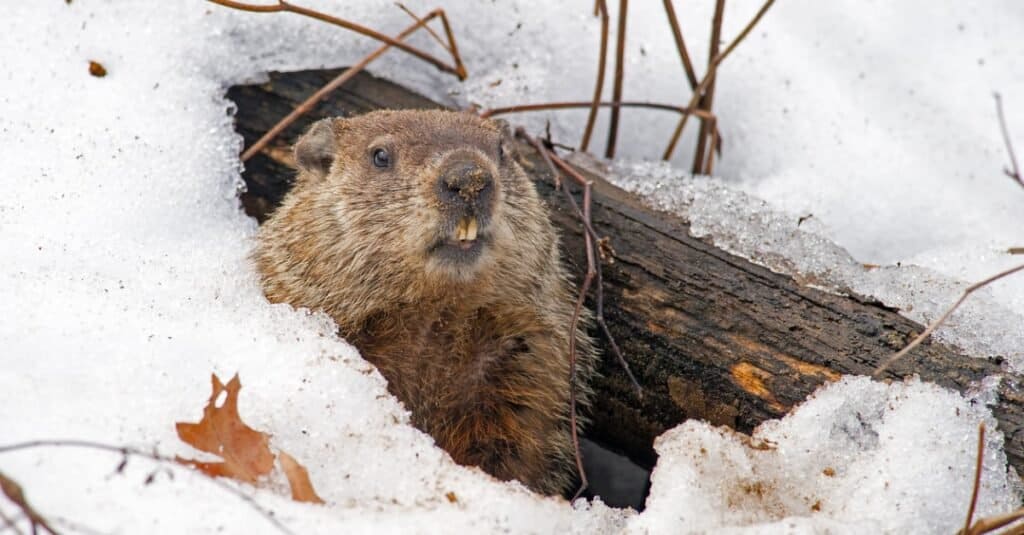
Groundhogs dig elaborate burrows where they live year-round and hibernate during winter.
©iStock.com/BrianEKushner
Groundhogs are intelligent animals with complex social interactions. They form close bonds with their young and whistle to communicate information about threats to each other.
Despite their bulky size, they are fast runners, good climbers, and excellent swimmers. It’s estimated they can reach a top speed of almost 10 mph.
These skills give them advantages against their predators. Groundhogs are constantly alert for threats, and it’s common to see them standing on their hind legs to survey their territory. They will whistle at each other when they sense threats, which has led to one of their common names, “whistle pig.”
Groundhogs hibernate every winter. During hibernation, their bodies slow down considerably – their breath slows from 80 beats a minute to five beats a minute. Their respiration drops from 16 breaths per minute to two per minute. Their body temperature drops from 99 degrees Fahrenheit to as low as 37 degrees.
They emerge from their burrows in early February. If an emerging woodchuck senses that winter is truly over, it will walk out of its burrow. If it judges that the weather is still too cold for foraging, it will return to its burrow.
This annual behavior has led to many myths about groundhogs and their ability to predict the weather. In the United States, groundhog predictions have led to the establishment of Groundhog Day. Held on February 2 every year, the highlight is watching a chosen rodent emerge from its burrow and decide whether to come out or return inside. While people think this depends on whether the groundhog sees its shadow, that myth isn’t true. The groundhog uses other senses to determine if winter is over.
According to tradition, if the animal doesn’t see its shadow, spring is around the corner. However, if he sees his shadow, he will return to his burrow, and we can expect another six weeks of winter. Many cities and states have their favorite prognosticators, but Punxsutawney Phil is undoubtedly the most famous.
Punxsutawney Phil: The Most Famous Groundhog That Ever Lived
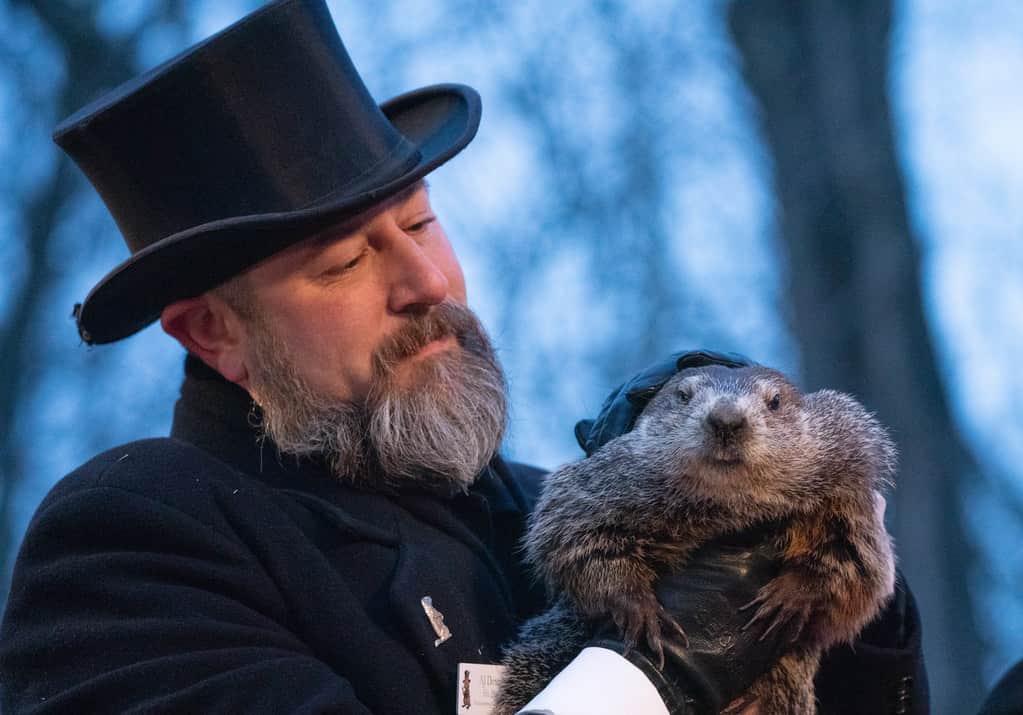
Punxsutawney Phil is famous all over the world for predicting the arrival of spring on Groundhog Day.
A resident of Punxsutawney, Pennsylvania, Phil has been “prognosticating” the weather since 1886. There have been many “Phils” since then, but Punxsutawney maintains a legend that Phil took an “elixir of life” that gave him eternal life.
The town established the tradition of visiting Gobblers Knob, the site of Phil’s burrow, in 1887. Today, visits to Gobbler’s Knob are a major source of income for the town. Thousands of tourists come to see Phil deliver his yearly weather prediction.
The story was immortalized in the 1993 movie Groundhog Day, in which Bill Murray was condemned to repeat Groundhog Day over and over until he learned to become a more caring person. The movie cemented Phil’s popularity and turned the town into even more of a tourist attraction.
The current Punxsutawney Phil lives in a climate-controlled, manmade burrow. You can visit him any time of year in Punxsutawney.

Punxsutawney Phil is on public display in a man-made burrow in Pennsylvania.
©Mark Van Scyoc/Shutterstock.com
Phil’s activities have not been without controversy. The animal welfare group People for the Ethical Treatment of Animals (PETA) has repeatedly asked the town of Punxsutawney to replace Phil with a robot. They say forcing Phil to live in captivity, travel to shows, and appear in front of crowds constitutes cruelty to animals.
According to the Introverted Activist blog, “Groundhogs are wild, prey animals, making them naturally fearful of situations like, say, being on constant public display…being handled by various humans in any capacity; being hoisted into the air before a huge crowd of people while being bombarded with loud sounds, bright lights, and other disturbing sensations, especially when they’d rather be hibernating.”
Despite these criticisms, there seems to be no move to replace Phil with a robot or an animal more used to being around humans.
Habitat
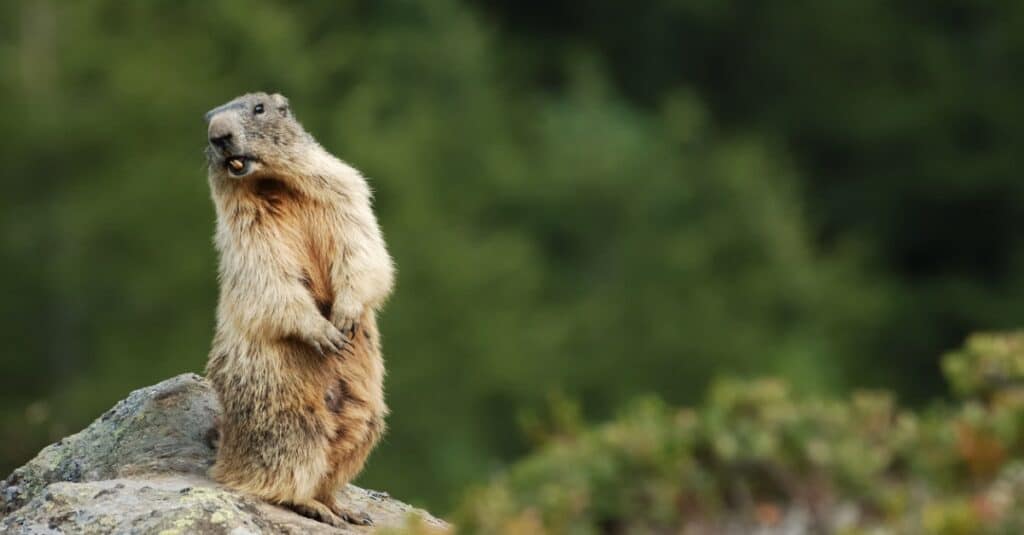
Groundhogs help maintain healthy soil conditions in woodland habitats by burrowing.
©iStock.com/gilles_oster
While most marmots live in rocky, mountainous areas, woodchucks prefer to live in regions of woodland and lowland plains. They live in fields, pastures, farmed areas, gardens, and hedgerows. In these habitats, they are considered vital habitat engineers, similar to the way beavers are critical habitat engineers in ponds. Woodchucks help maintain healthy soil conditions in woodland soils because of their constant burrowing activity.
They are burrowing rodents. They build extensive underground homes known as burrows, where they stash food, hide from predators, and raise their young. These complex settlements can grow quite large. Some burrows have been measured at 66 feet long.
Diet
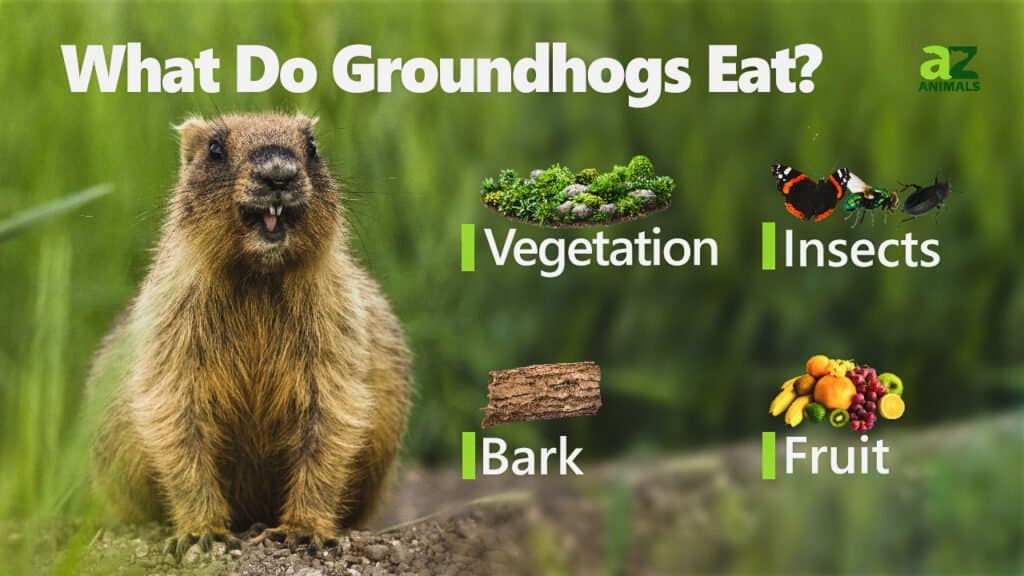
Groundhogs are omnivores, but their diet is mostly vegetarian. They primarily eat grasses, plants, flowers, fruits, tree bark, and vegetables. Some favorite groundhog foods include dandelions, sheep sorrel, buttercups, raspberries, clover, and alfalfa. On occasion, they may eat grubs, grasshoppers, and snails.
They are hearty eaters. They eat heavily during the spring, summer, and fall. They do this to build up fat reserves that will get them through three months of hibernation. In winter, they go into their burrows and hibernate.
Predators and Threats
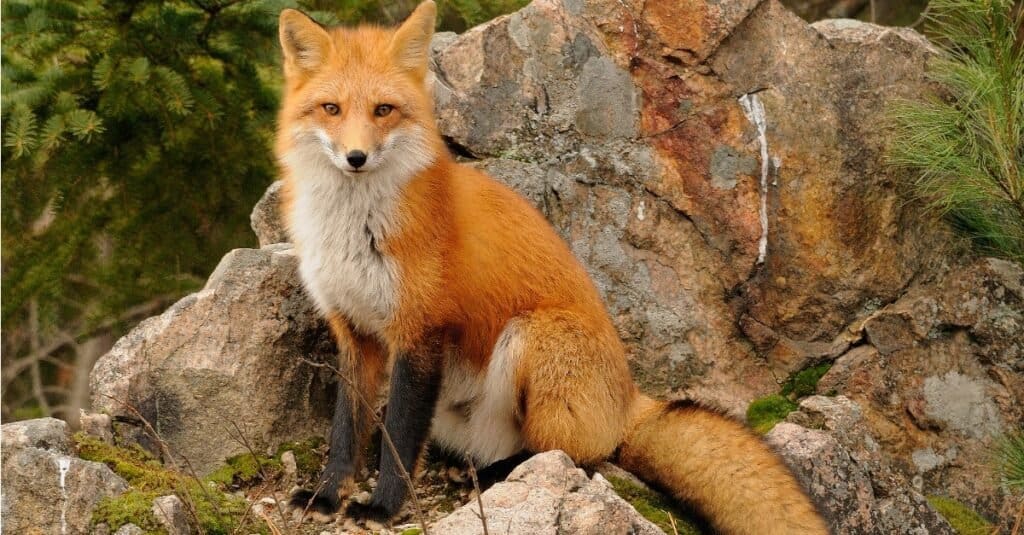
Foxes, coyotes, and bobcats are among the predators of groundhogs.
©iStock.com/Rejean Bedard
The groundhog is prey food for large carnivores, including coyotes, badgers, bobcats, and foxes. Raptors and small animals may sometimes eat their pups.
They have ways to protect themselves. Their teeth and claws are sharp, and they won’t hesitate to fight when threatened. Retreating into their burrows is also an excellent protective strategy because most animals won’t follow them underground.
Humans are another threat. These voracious eaters can eat their way through a backyard garden or a small farm in short order. Gardeners and farmers regularly attempt to keep them from devouring their crops. They are also a major target of legal hunting for their fur and meat.
Many people consider them pests, but one man decided to stop fighting nature and respond in an entirely different way. In a video that went viral on social media, he documented how he built an entire vegetable garden just for the local family of groundhogs.
Reproduction and Life Cycle
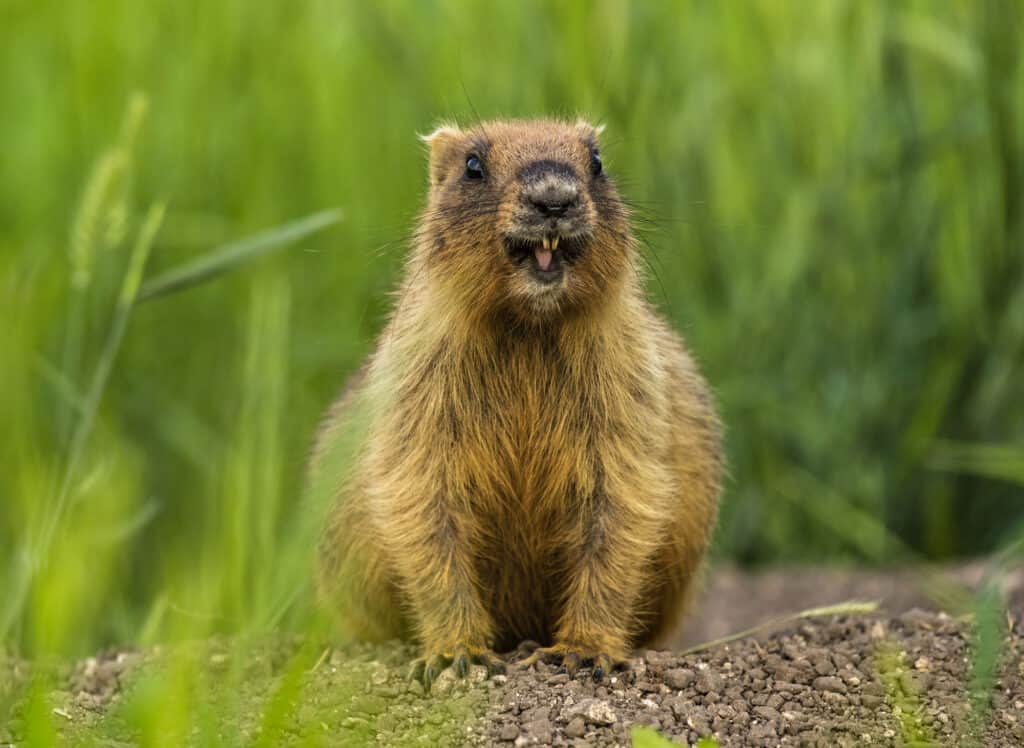
Female groundhogs give birth to two to six pups and cares for them for around three months.
©toha90/Shutterstock.com
In February, a male emerges from hibernation and goes looking for a female. He enters the female’s burrow and mates with her. After a gestation period of about 32 days, the female gives birth to two to six babies, which are known as pups.
The pups are born blind and hairless, and the mother feeds them for the first six weeks. At three months of age, they can forage and eat on their own. After about a year, most pups leave to build their burrows.
Groundhogs are not monogamous, but they may spend time together as family groups when they forage for food.
Most live about six years in the wild. In captivity, they can live up to 14 years.
Population
Groundhogs are native to the United States and Canada. Their estimated population is over 200 million.
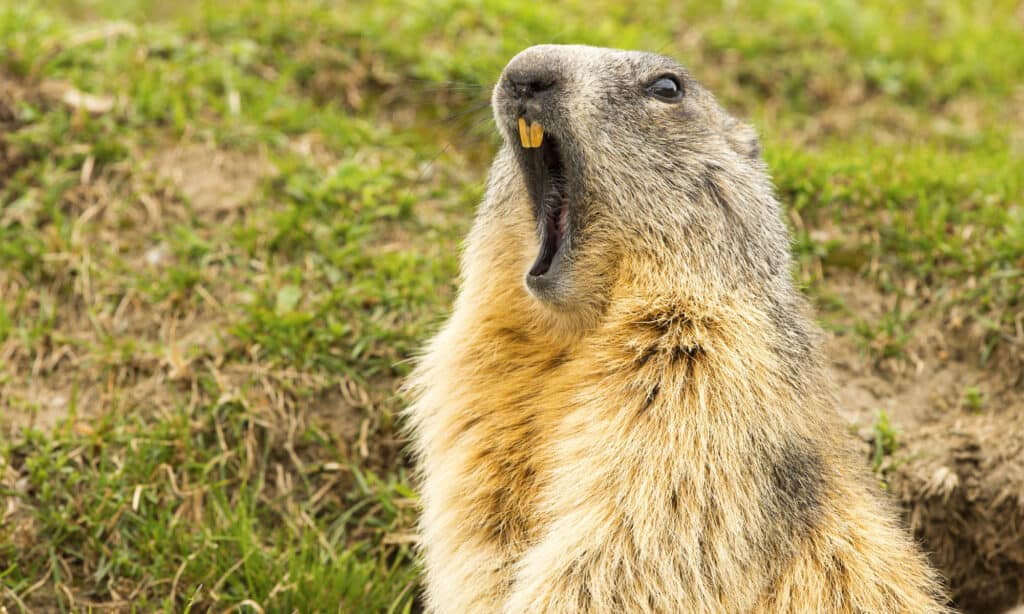
Groundhogs are quite vocal with calls that sound like whistling.
©Andrea Izzotti/Shutterstock.com
Enjoy Groundhogs Every Day
You don’t need to wait until Groundhog Day to enjoy these intelligent, amusing animals. You can see them in most wooded and forested areas in the United States and Canada. You may even have a family of them living in your backyard.
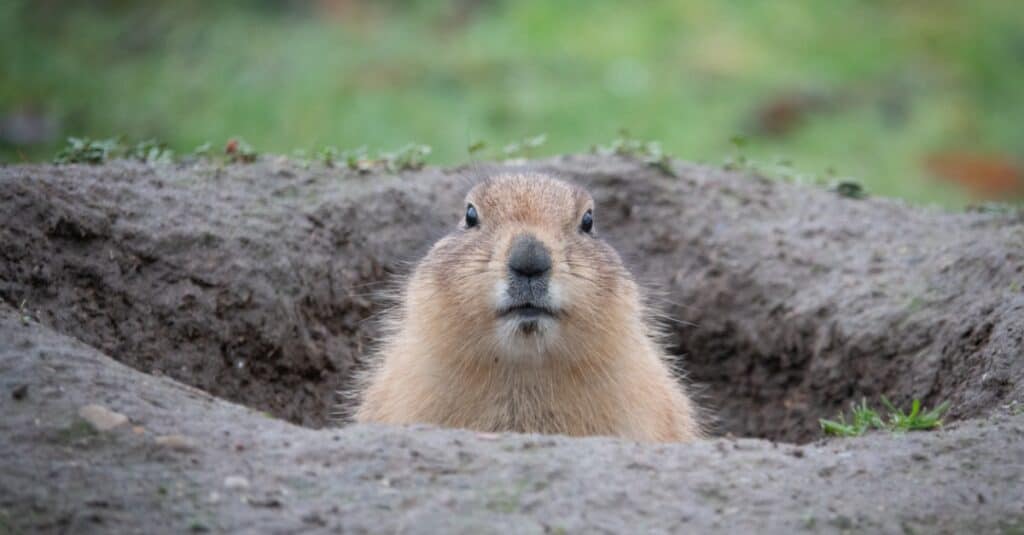
If your home is in the country or suburbia, chances are that a groundhog lives near you.
©iStock.com/undefined undefined
Groundhog (Woodchuck) FAQs (Frequently Asked Questions)
What is the difference between groundhogs and marmots?
Groundhogs are a species of marmot. In total, there are 15 different marmot species.
Groundhogs vs gophers
Groundhogs have thick bodies while gophers are slender and small. In addition, gophers create complex borrowing systems while groundhogs only borrow during nighttimes and winters and don’t store food.
What are the differences between a woodchuck, a groundhog and a gopher?
A groundhog and a woodchuck are the same. A gopher is related to a woodchuck, but there are key differences.
They are both marmots, and marmots are a type of ground squirrels. Gophers are also burrowing rodents, but they are much smaller than groundhogs. A typical gopher is about 6 inches long and weighs half a pound.
Groundhogs, like prairie dogs, are burrowing rodents who spend most of their time outside their burrows. They only use their tunnels to stash food and hide from predators. Both species prefer to spend their days outside watching their territory.
Gophers, on the other hand, spend most of their time in their burrows and only emerge to look for food and to mate. Gophers and prairie dogs do not hibernate.
How do I get rid of a groundhog?
If you have woodchucks in your garden and you’d prefer that they move, here are some ideas.
- Use a live trap to capture the groundhog and move it to another location.
- Spray a commercial or homemade repellent in your garden. Groundhogs will be discouraged by the smells of talcum powder, cat or dog fur, ammonia or Epsom salts.
- Plant their favorite grasses, including alfalfa, clover and zinnias, in an area away from your garden.
- Install fencing.
- Call a wildlife exterminator with experience in removing groundhogs.
What does a groundhog look like?
It is a large, stocky rodent with coarse fur. It has two long incisors on top of its mouth and two on the bottom. Groundhogs look like large squirrels, but their tails are flat and wide.
Are they friendly?
They are not friendly. Although groundhogs won’t attack unprovoked, they have aggressive natures and will fight fiercely if they feel threatened. Like all rodents, they are intelligent, and they’re fun to watch, but it’s best to enjoy them from a distance.
Are groundhogs dangerous?
Groundhogs are not generally dangerous, but there have been incidents where they bite humans. One particular worry with groundhogs is they can carry rabies. While there are just 1-3 rabies fatalities per year, when rabies is left untreated it has a 99.9% fatality rate and is a very serious virus.
How much wood could a woodchuck chuck?
Many people know the childhood tongue twister:
How much wood would a woodchuck chuck
If a woodchuck could chuck wood?
Believe it or not, science has attempted to determine that. In 1988, wildlife conservationist Richard Thomas did a study that attempted to figure this out. Woodchucks don’t chuck wood, of course, but he determined how much wood it could chuck if it used wood to build its burrow.
The answer is that a woodchuck, were he so inclined, could chuck about 700 pounds of wood a day. That’s a lot of wood!
What's the difference between a woodchuck and a beaver?
Beavers and woodchucks are from different species. Woodchucks are also made for digging holes and tunnels, while beavers are made for swimming. Beavers are also much larger than woodchucks.
What is the difference between a prairie dog and a groundhog?
The most obvious difference between a prairie dog and a groundhog is their size. Prairie dogs are much smaller than groundhogs, sometimes by as much as 2-3x.
What is the difference between a beaver and a groundhog?
The greatest differences between a beaver and a groundhog lie in their size, habitat, and diet. Beavers are larger than groundhogs by a significant amount, although groundhogs are likely the largest marmots in the world. Additionally, the habitat that the two live in is drastically different. Beavers are semi-aquatic animals that require a water source to live, while groundhogs are terrestrial animals that mostly live in underground burrows. Finally, the diets of a beaver and a groundhog are different. Beavers are famous for their woody appetites and eat the inner bark of a variety of trees. Groundhogs eat mostly grasses, flowers, shrubs, and crops.
What's the difference between a groundhog and a hedgehog?
There are many differences between a hedgehog and a groundhog, including their lifespans and sizes. Groundhogs dig complicated tunnels, while hedgehogs curl up into balls as their main form of defense.
Thank you for reading! Have some feedback for us? Contact the AZ Animals editorial team.
Sources
- National Geographic / Accessed October 21, 2021
- LiveScience / Accessed October 21, 2021
- The Punxsutawney Groundhog Club / Accessed October 21, 2021
- PETA / Accessed October 21, 2021
- Introverted Activists / Accessed October 21, 2021
- ThoughtCo. / Accessed October 21, 2021













